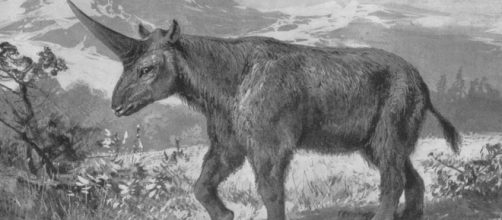Siberian unicorns, thought to have died long before humankind populated the planet, actually existed alongside them. Scientists revealed new research that proved they did not die out long before modern humanoids wandered Earth. In fact, the single-horned giant beast was around 39,000 years ago. The animal is thought to have sparked the myth of the unicorn. Radio-carbon dating findings were published in the journal Nature Ecology and Evolution. This proves they never died out as far back as thought. Previously, it was believed they went extinct up to 200,000 years ago.
The unicorn was a massive hairy rhino
Known as the Siberian Unicorn, the massive beast actually had lots of hair and sported just a single horn. It was a type of rhino, known scientifically as Elasmotherium sibericum, and survived in Central Asia and Eastern Europe, according to the BBC.
After conducting DNA tests, the animals were found to have deviated from other rhinos in development about 40 million years ago. It weighed in at up to four tons. This may not be the picture you have in mind of the elegant unicorns of myth and legend. However, whether you pretty it up or not, the fact is that it looks far more like a unicorn than the other animal suspected to be the origin of the myth - the narwhale.
Pony Unicorn Coloring Book (Games) https://t.co/qC2vHqi1Pk pic.twitter.com/dUDMkojZFL
— ponyapps (@ponynewapps) November 28, 2018
The Siberian beast may have died from a change of climate
After and during the Ice Age many animals died out and lots of those may have suffered from the change of climate. With extreme weather changes, vegetation and habitats change as well. Those animals with specialized diets may not be able to weather the change. Rhinos can be choosy about what they eat. The BBC noted that Prof Adrian Lister of the Natural History Museum said they could die if the environment changes. Modern-day rhinos may be helped through such studies as they too, don't just munch io any old bush or grass type.
Humankind may have helped kill off those animals already struggling with a loss of habitat. Hunting was a large source of food for early humans. Even today, while the animals are not hunted for food, they are slaughtered for the animal trade market. All the rhino populations are endangered today.
Unicorns lived among us? Sort of. According to new genetic research, a giant Ice Age rhino known as the “Siberian unicorn” co-existed with humans 39,000 years ago. https://t.co/QRVQj4Y9BR
— Twitter Moments (@TwitterMoments) November 27, 2018
Human myth of the unicorn
The actual myth of the source of the unicorn has been around as far back people can recall - possibly for thousands of years. According to the Encyclopedia Brittanica, "the unicorn was depicted in ancient seals of the Indus Valley Civilization and was mentioned by the ancient Greeks in accounts of natural history by various writers, including Ctesias, Strabo, Pliny the Younger, and Aelian." However, European legend has it as an attractive white horse-type of creature.
Stay in touch with interesting news like the Siberian unicorn by following the Viral Stories channel on Blasting Pop.

